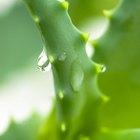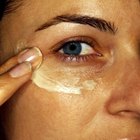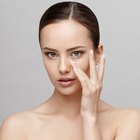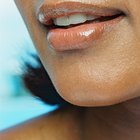
YUCELOZBER/iStock/Getty Images
Aloe vera is a widely used ingredient in herbal remedies and over-the-counter products for inflammatory skin conditions such as seborrheic dermatitis. Seborrheic dermatitis is a common skin disorder that affects the scalp, face, chest and groin area. Scientific studies show that aloe vera may be an effective treatment for this condition.
Seborrheic Dermatitis
Also referred to as seborrhea, seborrheic dermatitis is a common, chronic scalp condition. According to the Mayo Clinic, a frequent cause of this condition is irritated, oily skin, affecting areas on the body that are rich in oil glands, such as the eyebrows, nose, breastbone, the backs of the ears, the groin area and the armpits. It is characterized by red, greasy skin that gets covered with flaky yellow or white scales.
Aloe Vera
Aloe vera is a succulent perennial plant with fleshy, cactus-like leaves. The herb’s leaves contain a clear gel, the part of the aloe plant that is used as a topical treatment. The Gale Encyclopedia of Alternative Medicine notes that over 300 species of the herb have been identified, but aloe vera, or “true aloe,” is the species most widely used for medicinal purposes.
History
The use of aloe vera can be traced back to prehistoric times. The Natural & Alternative Treatments Health Library notes that medicinal aloe is depicted in an ancient cave painting in South Africa. According to the Gale Encyclopedia, aloe vera features in written records as early as1750 B.C. and was used by the ancient Egyptians for embalming and cosmetic purposes. Two Greek scholars, Pliny the Elder and Dioscorides, wrote of its healing effects. Aloe vera has been in use in the United States since the early 19th century.
Scientific Evidence
In a double-blind, placebo-controlled clinical trial published in the March 1999 Journal of Dermatological Treatment, the efficacy of an emulsion derived from an extract of aloe vera was studied. The results showed a significant reduction in symptoms of scaliness and pruritus as well as the number of sites affected by seborrheic dermatitis. There was a 58 percent improvement among participants treated with aloe vera, compared to a 15 percent improvement among placebo-treated participants. The study results indicate that an extract of aloe vera is an effective treatment for seborrheic dermatitis.
Dosage
The University of Michigan Health System recommends that you use aloe vera topically as directed on the package or by your doctor or other licensed health provider. You should also follow package directions on how to store aloe vera to protect it from light and moisture.
Related Articles

What Is Aloe Good For?

List of Retinoids

Benefits of Shea Butter and Coconut Oil ...

How to Remove Dandruff With Baking ...

Aloe Ferox Benefits

What Are the Benefits of Ashwagandha in ...

Skin Care Products That Contain ...

What Are the Benefits of Extrapone ...

How to Heal an Inflamed Bikini Area

How to Cover a Really Red Scar

How to Use Pyrithione Zinc for Rosacea

Castor Oil for Joint Pain

Can Age Spots Be Reversed?

The Best Facial Moisturizer That Won't ...

The Best Facial Moisturizers for People ...

Hydroquinone & Dark Circles

Home Remedies to Permanently Remove ...

Can Borage Oil Help Acne?

Chasteberry for Acne

How to Cure Razor Burn on a Woman's ...
References
- “The Gale Encyclopedia of Alternative Medicine;” Jacqueline L. Longe; 2004
- The Natural & Alternative Treatments Health Library: Aloe
Writer Bio
Based in Blue Springs (MO), the ArmChairGeek has worked as a freelancer since 2007. An alumni of the University of California, San Marcos, he specializes in writing health-related eBooks, articles and other web content for a number of websites, including Demand Studios, eHow and WiseGeek.
Photo Credits
YUCELOZBER/iStock/Getty Images